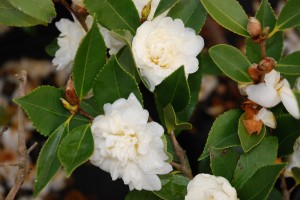‘Snow Flurry’ camellia is a broadleaf evergreen shrub with good plant vigor. It was one of the first zone 6 cold hardy camellias hybridized by Dr. William Ackerman and released by the U.S. National Arboretum in 1986.
Snow Flurry grows into a 4 feet tall by 6 feet wide shrub over a 10 year span. Branching is mostly upright with branch tips bending downward, mostly from weight of the numerous flowers produced. The medium-sized (3 ½ inch) white flowers open in early autumn. Flower shapes may vary from peony to anemone types on the same shrub.
Camellia culture is similar to rhododendrons. Camellias prefer partial sunlight (6-hours minimum) for optimal flowering. Garden soil should be moist, well-drained, and slightly acidic. The planting site should be generously amended with peat moss and /or compost. Plant shrub(s) shallow in a wide planting hole, slightly above soil grade, and spread 2-3 inches of an organic mulch around each shrub. The planting site should be partially sheltered from winter’s desiccating winds and direct afternoon sunlight year-round.
Camellias require little to moderate pruning annually, depending on the cultivars grown. Pruning is best performed in mid to late April before new vegetative growth begins. Newly planted shrubs are drought susceptible, but two-year established camellias tolerate summer dry spells well. Their lustrous green foliage is tolerant of coastal sea salt spray.
Fertilize with acidic- based plant foods such as Hollytone™, Miracle-Gro™ and Miracid™. Follow package directions and don’t fertilize camellias after August 15th.
Currently, disease and insect problems are almost non-existent in zone 6 areas of the Southern Appalachian region (USDA zones 6 and 7).


 Posted in
Posted in 

Flurry Of Hummingbirds Garden Flag
[…] nually, depending on the cultivars grown. Pruning is best performed in mid to la […]